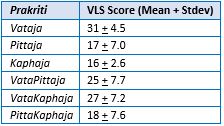Relation of Prakriti and Skin Color - An Observational Study
DOI:
https://doi.org/10.21760/jaims.7.3.4Keywords:
Prakriti, Skin color, Von Luschan's chromatic scale, Fitzpatrick scale, AyurvedaAbstract
Prakriti is one of the most important concepts in Ayurveda which is of 7 types i.e., Vataja, Pittaja, Kaphaja, three Dwandaja and one Sannipataja. Prakriti is first Pariksha mentioned in Charaka Samhita among Dashavidhapariksha. Assessment of Prakriti is done based on Anatomical, Physiological, Psychological, and Behavioural factors. Twak Shareera is one of the important anatomical features used in the assessment of Prakriti. In this article, an attempt is made to understand the color of Twak and its relationship with Prakriti. An observational study of 150 healthy subjects was conducted to assess the Prakriti of individual and its relationship with Twak Shareera. We used Von Luschan's chromatic scale (VLS) and The Fitzpatrick scale for classifying skin color. The more the VLS Score, the darker the skin color is. The present study showed that VLS Score increases wherever there is involvement of Vata and Fitzpatrick scale showed that Vataja Prakriti are more of Dark brown in color compared to Pitta. Thus, it can be said that skin color is Genetic in nature and correlated with our theory of Prakriti.
Downloads
References
Agnivesha. Charak Samhita. Varanasi: Chaukhamba Bharti Academy. Sutrasthana, Vol 7, Vidyotini Hindi Commentry by Kashinath Shastri and Gorakhanath Chaturvedi; 1998;pp39–40.
Sushruta. Sushruta Samhita. Varanasi: Chaukhamba Sanskrit Samsthana. Sharirsthana, Vol 4, Ayurvedatatva Sandipika Hindi Commentry by Kaviraj Ambikadutt Shastri; 2001;p62.
Vagbhatt. Ashtang Hridya, Vidvanamanoranjini Hindi Commentry by Kashinath Shastri. In: Tripathi Indradev, Tripathi Shrikant, editors. Varanasi: Krishnadas Academy. Sutrasthan, Vol 1, 1194;pp9-10.
YT Acharya (Ed). Charaka Samhita of Agnivesha, Vimansthana; chapter 8, Verse 94. Chaukhamba Surbharati Prakashan, Varanasi, 2011, reprint 2011.
Harish Rotti, Ritu Raval, Suchitra Anchan, Bellampalli, Sameer Bhale, Ramachandra Bharadwaj, et al. Determinants of Prakriti, the Human Constitution Types of Indian Traditional Medicine and its Correlation with Contemporary Science. J Ayurveda Integr Med. 2014 Jul-Sep; 5(3): 167–175.
Agnivesha. Charak Samhita. Indriyasthana. Varnasvariyamindriyam, 8th Quote accessed from http://niimh.nic.in/ebooks/ecaraka/(e-Samhita Designed and Developed by National Institute of Indian Medical Heritage, Hyderabad) accessed on 18th March 2018
Agnivesha. Charak Samhita. Indriyasthana. Varnasvariyamindriyam, 8th Quote accessed from http://niimh.nic.in/ebooks/ecaraka/(e-Samhita Designed and Developed by National Institute of Indian Medical Heritage, Hyderabad) accessed on 18th March 2018















